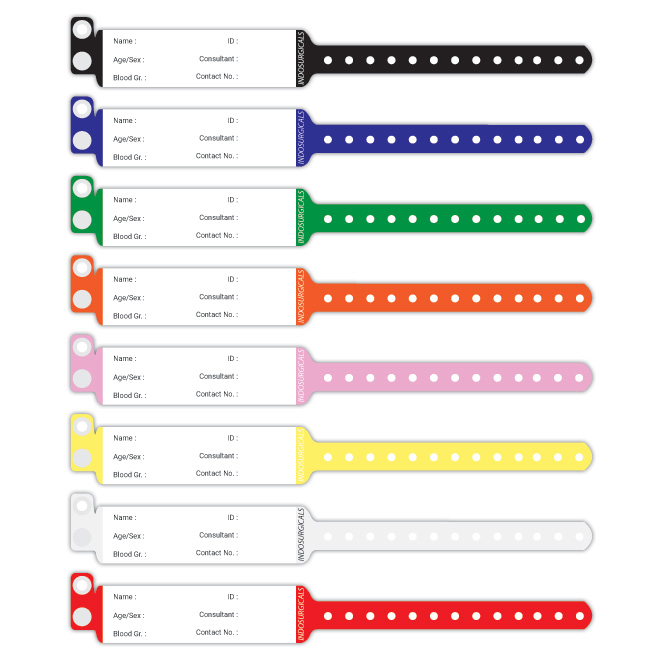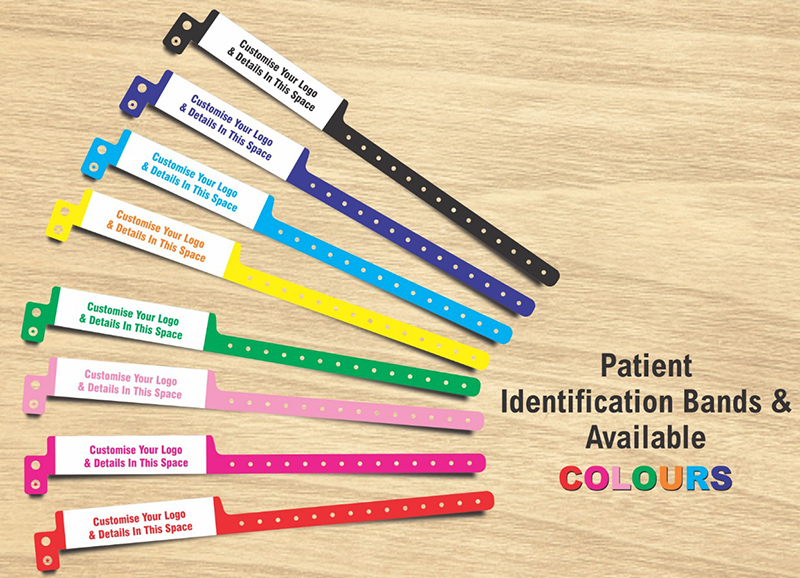A Comprehensive Guide to the Distinct Types of Patient Identification Band
A Comprehensive Guide to the Distinct Types of Patient Identification Band
Blog Article
Checking Out the Different Types of Patient Identification Band Used in Clinical Facilities
In the intricate world of healthcare, the essential duty of Patient Identification bands often goes undetected. These bands, differing from easy paper wristbands to sophisticated RFID bands, form the backbone of Patient security methods, making certain precision in Patient Identification. The substantial diversity of these bands, each with its special benefits and restrictions, is typically overlooked. As we navigate through this subject, one may gain understanding into the refined complexities and vital importance of such bands in clinical centers.
Recognizing the Significance of Patient Identification Bands
While they might appear like plain accessories, Patient Identification bands play an essential function in medical centers. These bands act as an essential tool for validating Patient identity, protecting against medical errors related to misidentification. The bands typically show crucial information such as the Patient's name, age, blood group, and any kind of known allergies. They enable health care experts to promptly access this vital details, thereby promoting precise and punctual clinical therapy. Patient Identification bands additionally aid in improving administrative tasks, making sure exact record-keeping and payment. Regardless of their simplicity, these bands embody the concept of Patient safety, a cornerstone of top quality health treatment. Without them, the risk of clinical mistakes, and consequently, Patient damage, may considerably enhance.
Traditional Paper Wristbands: Their Use and Limitations
Traditional paper wristbands have actually been a staple in Patient Identification throughout different medical centers. While their usage prevails, they nurture particular restrictions that may influence their efficiency in Patient monitoring. This area will certainly concentrate on the scope of their application and the integral downsides related to their use.
Paper Wristbands: Use Scope
In the realm of Patient Identification, paper wristbands have actually long held an important duty. These bands are typically used in outpatient setups, where the Patient's keep is short-term. In spite of innovations in innovation, the modest paper wristband remains a cost-efficient and reliable solution for Patient Identification in various healthcare scenarios.
Limitations of Paper Wristbands
In spite of their extensive usage, paper wristbands are not without their disadvantages. Their physical toughness is just one of the substantial constraints. Direct exposure to water, sweat, or rough handling can make them unreadable or perhaps cause them to disintegrate. Furthermore, paper wristbands frequently lack the technological capabilities of even more modern-day choices, such as barcoding or RFID chips, restricting their capability to simply showing composed information. The lack of ability to update or modify the data on the wristband is an additional imperfection. If the info is handwritten, legibility can be endangered, leading to prospective misidentification. Lastly, paper wristbands can create pain or skin inflammation to some clients, especially when put on for prolonged periods.
Barcoded Wristbands: Developments in Patient Identification
While Patient Identification has long been a crucial facet of health care, the arrival of barcoded wristbands represents a substantial leap onward. These bands utilize the simplicity of barcoding modern technology, permitting Patient details to be rapidly checked and accessed. They enhance the speed and precision of Patient Identification, minimizing the threat of medical mistakes associated with misidentification. Barcoded wristbands are affordable, simple to create, and get rid of handwriting mistakes common with hands-on systems. Nonetheless, they are not without restrictions. While they offer renovations over standard bands, the barcode can come to be smudged or worn, making it unreadable. Regardless of this, barcoded wristbands remain a necessary device in modern healthcare settings, representing the junction of modern technology and Patient treatment.
Radio Regularity Identification (RFID) Bands: a Step Towards Futuristic Healthcare
The evolution of Patient Identification bands has actually produced the appearance of Superhigh frequency Identification (RFID) Bands (patient identification band). These ingenious devices present essential advantages for healthcare facilities, offering an extra reliable and technically advanced means of Patient Identification. The implementation of RFID in medical care is a substantial step towards a more advanced technique to Patient administration and safety
Understanding RFID Bands

RFID Bands: Secret Advantages
Embracing a future where technology and healthcare merge, superhigh frequency Identification bands supply numerous crucial advantages. Mainly, these bands improve Patient safety and security by giving exact, immediate Identification, thereby reducing clinical errors. RFID bands can store a substantial amount of Patient data, consisting of case history and allergies, enabling individualized care. They also simplify administrative tasks, as the automated data access changes manual procedures, enhancing efficiency and reducing documentation. Furthermore, RFID bands provide real-time monitoring of individuals, critical in risky settings such as surgical procedure or intensive care. These bands are resistant and durable to environmental factors, making certain constant capability. In general, RFID bands stand for a significant improvement in Patient Identification innovation, profiting both patients and doctor.
Applying RFID in Healthcare
As we enter a technologically sophisticated age, the application of RFID bands in healthcare becomes increasingly important. These bands offer a smooth way to track and identify patients, ensuring their safety and improving efficiency in treatment procedures. RFID bands offer numerous benefits over traditional Identification approaches. They can save a substantial read what he said quantity of information, including the Patient's case history and therapy strategies, which can be quickly accessed by doctor. This information assists doctors make informed choices pertaining explanation to the Patient's treatment strategy. In addition, RFID bands lower clinical errors by providing exact Patient Identification, which is crucial in preventing misdiagnosis or incorrect medication administration. Therefore, the implementation of RFID bands is a substantial action towards boosting Patient safety and security and health care delivery.

Color-Coded Wristbands: Aiding in Quick and Accurate Medical Diagnosis
In the dynamic atmosphere of a clinical facility, color-coded wristbands have actually arised as important devices for swift and precise Identification of a person's medical problem. These wristbands, worn by people, bring details colors that correspond to various clinical conditions or conditions. This system is made to offer instant aesthetic signs to healthcare suppliers, enhancing Patient security and care top quality.
Strategies for Effective Application and Monitoring of Patient ID Bands
Achieving ideal use Patient Identification bands requires a well-structured approach for their implementation and management. The primary step includes training all wellness employees on the relevance of correctly applying and checking out these bands. Secondly, health centers need to systematize using ID bands throughout all divisions, ensuring uniformity and reducing discrepancies. Routine audits must be carried out to verify adherence to policies and to correct any type of variances. Patient education is additionally critical; people have to recognize the function of the bands and the need for their constant wear. patient identification band. Last but not least, it's necessary to have a backup plan in position, such as barcode scanning or biometrics, to make sure that Patient Identification is never ever endangered.
Verdict
Patient Identification bands are crucial in clinical facilities to make certain safety and accuracy. Typical paper, barcoded, RFID, and color-coded wristbands each hold special benefits, ranging from cost-effectiveness to innovative data storage space and instantaneous medical signals. Effective execution and management of these bands can substantially minimize medical errors, improve efficiency, and enhance total Patient care. Therefore, understanding and making use of these Identification tools is vital for maintaining high standards in health care.
These bands, differing from straightforward paper wristbands to advanced RFID bands, form the backbone of Patient security procedures, making certain accuracy in Patient Identification.The evolution of Patient Identification bands has actually brought about the development of Radio Regularity Identification (RFID) Bands. Overall, RFID bands represent a significant development in Patient Identification technology, benefiting both clients and healthcare companies.
RFID bands minimize clinical mistakes by supplying precise Patient Identification, which is important in avoiding misdiagnosis or wrong medication administration. Patient education and learning is additionally vital; individuals need to comprehend the function of the bands and the requirement for their constant wear.
Report this page